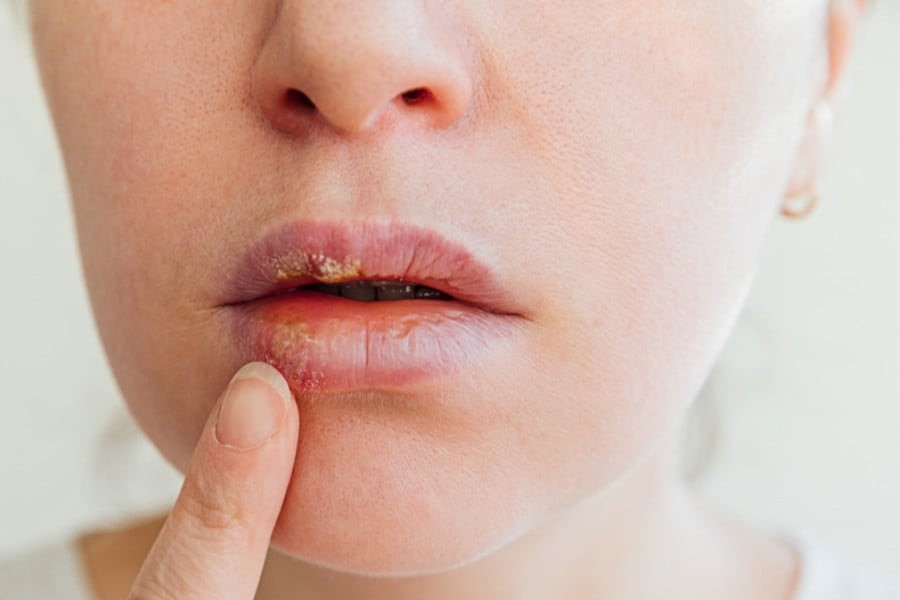
Herpes Simplex: symptoms and treatment
Herpes Simplex is an infection caused by viruses of the herpesvirus family. Two types are known: HSV1, which prefers the upper part of the body and the oropharyngeal mucosa transmitted by interhuman contact, by the saliva of healthy carriers or by active herpetic lesions; HSV2, which prefers the genital areas, is essentially a sexually transmitted disease.
The manifestations of herpex simplex appear in a particular sequence: primary infection, latency, multiple recurrent infections
The primary infection is often inapparent and many individuals are carriers without ever having contracted the infection.
The primary form caused by HSV1 is acute herpetic gingivo-stomatitis, which mainly affects children from 6 months to 3 years of age, has an incubation time of 6 days, mucous membrane pain with sialorrhoea (profuse salivation), sore and bleeding gums, also affecting the lips, chin and cheeks, with typical cluster vesicles.
It is accompanied by a high fever of 39°C, malaise.
It evolves with healing in 10 – 15 days.
The primary genital form is most often related to HSV2, but not always; in females the form is very intense with painful vulvar and vaginal involvement with fever and malaise, difficulty urinating.
Enlargement of the inguinal lymph nodes is constant, lesions spread to the pubis, buttocks and thighs.
In men the form is so much less intense that it can be confused with a secondary relapse.
Almost 100% of the population harbours the virus in a latent state, in about 20% of the population secondary forms occur due to a drop in immunity, stress, menstrual cycle, trauma or other infections that can lead to reactivation of the virus and the appearance of relapses with the characteristic vesicles.
In fact, the virus disappears from the skin lesions and remains latent in the body to localise in the corresponding sensory ganglia, Gasser’s ganglion for the labial form and the sacral ganglion for HSV2 where they can remain silent even for life, without giving any sign of their presence and without being ‘attacked’ by the antibodies circulating in the blood.
Herpes simplex: secondary forms
Labial herpes
The most common form is cold sores: the characteristic blisters affect the face; specifically the lips, nostrils, cheeks, the inside of the mouth (affecting the tongue and/or gums) and – more rarely – the eyes.
It usually appears due to a drop in immune defences, fever, stress, intense exposure to sunlight or after eating particular foods.
Genital herpes
A further form of herpes is the genital infection, which affects the genital organs and is contracted through sexual contact.
In men the blisters are located on the penis, scrotum and around the anus; in women they occur at the entrance and inside the vagina, on the labia majora and labia minora, on the clitoris and around the anus.
Symptoms of secondary forms of herpes simplex
Herpes simplex manifests itself with characteristic blisters on the skin of the face or genital organs.
Labial herpes
Symptomatology generally begins with a burning, tingling or itching sensation; within a few hours an erythema appears followed by vesicles, filled with fluid, which converge to form a blister that opens and is covered with yellowish crusts.
Genital herpes
The characteristic symptom of genital herpes is the appearance of small, annoying and painful whitish blisters on the genital organs (also inside the vagina).
Today, it is the major cause of ulcerative genital lesions and, especially in pregnant women, the risks to the newborn child are serious.
Treatment of herpes simplex
Pending the development of a specific vaccine, there is no drug that definitively resolves the disease.
For primary forms, the treatment of choice is general antiviral therapy, which brings about rapid improvement, but is not able to destroy the virus, which lies silent in the corresponding ganglia and therefore does not reduce the possibility of recurrence.
In secondary forms affecting the face (lips, nostrils, etc.), it is best to use specific antiviral creams, which should be applied to the spot where the vesicles are forming as soon as the first symptoms are felt, after which an antibiotic or healing cream is preferable.
In cold sores, it is also advisable to protect the lips with a sun filter and to avoid food that is too hot or too cold, which may bother the injured areas.
In genital herpes both as a primary infection and as a relapse, general antiviral therapy and topical antibiotics or healing is indicated, and obviously protected intercourse.
Protocols currently used to try to suppress recurrences, carried out with antivirals over long periods of time, have not had the desired effects.
Advice against herpes simplex
It is advisable to eat a diet rich in fruit and vegetables, so as to provide the right amount of vitamins (especially vitamin C) and minerals (especially iron and magnesium): honey, citrus fruits and royal jelly should not be missing from one’s daily diet.
Also, consume those foods (fish, meat, dairy products) that contain ‘lysine’, a particular amino acid believed to slow herpes recurrences.
In cold sores – being a highly contagious disease – contact with other people should be avoided; moreover, one should not scratch oneself and should wash one’s hands often and thoroughly, avoiding touching areas of the body not affected by herpes (especially the eyes) to prevent them from being attacked by the infection.
In genital herpes, as with all infections that can be transmitted during sex, the use of condoms is the only suitable weapon to prevent contagion.
Read Also:
Emergency Live Even More…Live: Download The New Free App Of Your Newspaper For IOS And Android
Herpes Zoster, A Virus Not To Be Underestimated
A. Resistant Bacteria: The Important Discovery Of Australia
Bacterial Infections: When To Use Antibiotics?
Bacterial Infections, Herpetic Whitlow: What Is It And When Do I Need To See A Specialist?
What Is Impetigo In Adults And Children And How To Treat It
Shingles, The Painful Return Of The Chickenpox Virus


